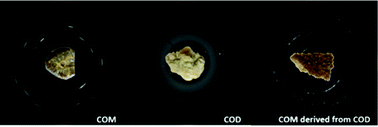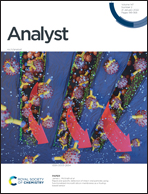Discriminating the origin of calcium oxalate monohydrate formation in kidney stones via synchrotron microdiffraction†
Abstract
Nephrolithiasis is a multifactor disease that produces nephrolites in the kidneys. Calcium oxalate hydrate (dihydrated, COD, or monohydrated, COM) stones are the most common ones with more than sixty percent incidence worldwide. They are related to different pathologies, COD with hypercalciuria and COM with hyperoxaluria. COD is an unstable species and transforms into COM (herein named TRA to distinguish the origin of the monohydrated species). TRA and COM are chemically and crystallographically identical leading to misdiagnosis and recurrence increase. In the current study, the composition and crystalline structures of several calcium oxalate stones, classified by morpho-constitutional analysis, were examined by IR and synchrotron through-the-substrate micro-X-ray diffraction (tts-μXRD). Both IR and linear diffractogram studies were able to distinguish between the monohydrated and dihydrated phases but not between COM and TRA, as expected. The analysis of 2D diffraction patterns revealed that TRA showed a lower degree of crystallinity and less texture with respect to COM which can be used as a signature to distinguish between the two. This study confirms that despite the subtle differences between COM and TRA, the origin of the monohydrate oxalates can be unraveled using tts-μXRD. This valuable information should be taken into account in order to improve patients’ diagnosis and reduce recurrence by considering and treating the origin of the formed stones.



 Please wait while we load your content...
Please wait while we load your content...